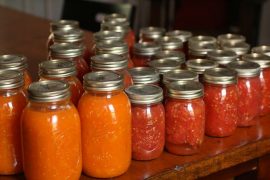As a child, the only time I ever heard my mother use the f-word was in reference to green beans. It was the summer that my father put in a huge garden at our house, and she was sick of it. When he came home from work one day, asking if she had picked the green beans, she threw down her dishtowel and responded with: “You go out there and pick the you-know-what green beans.”
That was the last time we ever had a garden, but it certainly wasn’t the last time my mother canned. As a little girl, I never had store-bought green beans, canned tomatoes or pickles. These were all preserved in Ball jars and stored in the basement for year-round eating. And while I’ve never canned myself, I am interested in at least pickling a few cukes this summer.
So where’s the math? Well, it’s everywhere in canning. Just like with cooking, preserving foods requires recipes — and then there’s the part about taking a huge pile of fruits or veggies and divvying them up into a series of jars. Yep, math.
See, canning is hot, hard work. In the middle of summer, you need to boil large pots of water, keep the jars warm in a hot dishwasher, the oven or a water bath. The last thing you want to do is run out of jars or lids in the middle of this entire ordeal. Doing the math upfront means you can get in and out of the kitchen without an added trip to the store (or your next door neighbor’s).
Turns out there are easy-to-follow charts and tables for dealing with yield. But if your garden — or trip to the farmer’s market or pick-your-own farm — doesn’t yield the exact amount on the chart, you’ll need to do a little math.
Drew’s humble green-bean patch is overflowing. After convincing the kid down the street to pick all of them (for a small fee, of course), he sits down in front of the television to snap them. (The Olympics and snapping green beans are a perfect combo.) At the end of a few hours, he estimates that he has about 16 pounds of green beans. Whoa.
If he cans all of these beans, how many quart jars will he need? Turning to a trusted web source, he learns that a quart jar will hold about 2 pounds of green beans. Easy math: 16 ÷ 2 = 8. So he’ll need 8 quart jars.
He’s got 15 quart jars in the basement, so the green beans are covered. But he also needs to put away his tomatoes. Will he need to buy more jars?
After canning the green beans (and not using the f-word even one time — such restraint!), he considers those ruby red fruits. This time, he picks them himself, ending up with about 15 pounds. Consulting his yield chart again, he is faced with another decision: crushed or halved/whole? Canning tomatoes is a little more work, since he’ll need to skin them first. He decides to look at the yield for each option before making up a plan.
Crushed tomatoes yield 2.75 pounds per quart, while halving them or leaving them whole yields 3 pounds per quart.
Crushed: 15 pounds ÷ 2.75 pounds= 5.5 quarts (about)
Halved/whole: 15 pounds ÷ 3 quarts = 5 quarts
He’s already used 8 of his 15 quart jars, leaving him with 7. So he’ll have plenty of jars either way. If he crushes the tomatoes, he’ll need a couple of pint jars (because there are 2 pints in a quart). So, he decides to leave the tomatoes whole (or cut them in half, if necessary).
And with two quart jars left over, he decides it’s time for pickles!
Do you have plans to can anything this summer? Share your resources, tips, recipes and more in the comments section. I need inspiration!
A programming note: I am changing my posting schedule a little — at least for the summer. Math at Work Monday interviews will now appear twice a month, rather than every Monday. If you have suggestions of folks I should interview, let me know!
